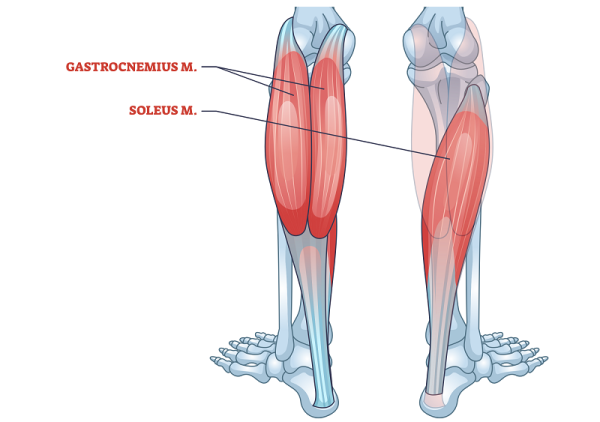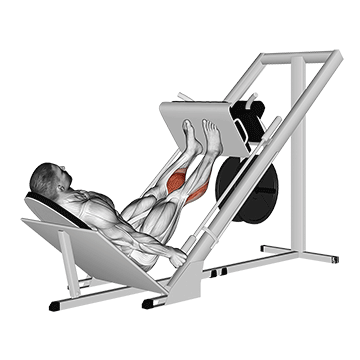Overview
The leg press calf raise is an isolation lower-leg exercise performed on a 45-degree leg press machine, focusing on ankle plantarflexion to target both the gastrocnemius and soleus muscles. It allows the user to apply heavier loads with controlled resistance while minimizing strain on the spine and upper body. This variation is ideal for progressive overload, safe muscle growth, and strength development in the calves, particularly in structured lower-body training routines.
How to Perform Leg Press Calf Raise
Setup: Sit on the leg press machine and place the balls of your feet shoulder-width apart on the lower portion of the footplate, with heels hanging off.
Adjust the Load: Load the machine with a moderate to heavy weight that allows full range of motion without bouncing or locking the knees.
Starting Position: Extend your knees fully (without locking out) to stabilize the position. Keep your legs straight and hips braced against the pad.
Raise: Press through the balls of your feet and lift your heels as high as possible, engaging the calves at the peak of contraction.
Pause and Contract: Hold the top position for 1–2 seconds to emphasize maximal muscular recruitment.
Lower Slowly: Lower your heels under control until you feel a deep stretch in the calves.
Repeat: Perform the desired number of repetitions, maintaining consistent tempo and tension throughout.
Tips for Proper Form
Keep knees extended but soft: Do not lock the knees; maintain slight tension to keep the legs stable.
Use a controlled tempo: Avoid bouncing at the bottom, which places stress on the Achilles tendon.
Maximize range of motion: Let the heels dip below the platform and lift fully to enhance muscle recruitment.
Keep the feet flat: Avoid rolling the ankles inward or outward to prevent joint strain.
Maintain constant tension: Don’t rest between reps; keep the calves loaded throughout the set.
Common Mistakes
Using excessive weight, leading to partial reps or momentum-based lifting.
Bouncing at the bottom, which increases joint stress and reduces effectiveness.
Not achieving full plantarflexion, limiting peak contraction.
Locking the knees, which can shift the load away from the calves and onto the joints.
Letting the heels rest between reps, which reduces training intensity.
Benefits of the Leg Press Calf Raise
Targets both major calf muscles: Effectively activates the gastrocnemius and soleus for complete development.
Enables progressive overload: Allows the use of heavier weights compared to standing or seated variations.
Reduces spinal loading: Seated position minimizes strain on the back, ideal for individuals with spinal limitations.
Enhances ankle strength: Strengthens the plantarflexion mechanism essential for jumping, running, and agility.
Safe for most lifters: Stable machine setup reduces balance challenges and injury risk.
Provides deep range of motion: The footplate allows heels to drop lower than flat ground, increasing eccentric loading.
Suitable for high-volume training: Easily adjustable loading makes it ideal for hypertrophy and endurance protocols.
How to Incorporate Into Your Routine
For Beginners: Start with light to moderate weight and perform 2–3 sets of 12–15 reps to learn the movement pattern.
For Hypertrophy: Use 3–4 sets of 15–20 reps with moderate to heavy loads and a 1–2 second pause at the top.
For Strength: Perform 4–5 sets of 8–12 reps with heavy resistance and controlled execution, resting 60–90 seconds between sets.
For Functional Training: Include in lower-leg stability protocols alongside balance and ankle mobility exercises.
For Circuit Training: Add 12–20 reps into a leg circuit, particularly at the end of a workout to fully fatigue the calves.
For General Fitness: Perform 2–3 sets of 10–15 reps weekly to maintain ankle function and calf development.
For Athletic Performance: Combine with plyometrics or sled work to reinforce explosive push-off and sprint mechanics.
Leg Press Calf Raise: Muscles Worked

Frequently Asked Questions
Is the leg press calf raise better than standing calf raises?
Not necessarily better—just different. It isolates the calves more safely with heavier load capacity and less spinal stress. Ideally, both should be used for comprehensive calf development.
How deep should I let my heels drop?
Allow the heels to drop below the footplate level for a full stretch, but avoid overstretching if you have limited ankle mobility.
Can I use one leg at a time?
Yes. Performing single-leg leg press calf raises can help correct imbalances and increase unilateral strength.
Should I train calves at the beginning or end of my worko
They can be trained either way, but placing them earlier in the session may yield better hypertrophy results due to reduced fatigue.
How often should I do leg press calf raises?
Calves can be trained 2–4 times per week, especially if using alternating rep ranges and variations to avoid plateau.

